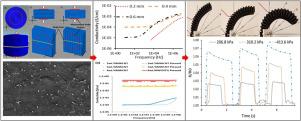Additive Manufacturing ( IF 11.0 ) Pub Date : 2020-05-12 , DOI: 10.1016/j.addma.2020.101281 Cameron J. Hohimer , Gayaneh Petrossian , Amir Ameli , Changki Mo , Petra Pötschke

|
With applications in flexible electronics and soft robotics, the ability to fabricate elastic functional materials with complex geometries has become highly desirable. In this work, flexible thermoplastic polyurethane/multiwalled carbon nanotube (TPU-MWCNT) composites were printed using multi-material fused filament fabrication (FFF) to study their feasibility towards built-in sensing capabilities in soft robotics. The microstructure, electrical conductivity, capacitive sensing, and piezoresistive sensing of the printed samples were investigated. MWCNT content, print orientation, and layer height was found to be the most influential parameters on the electrical properties while the nozzle and bed temperatures showed insignificant impacts. Overall, the in-line and through-line conductivities were one order of magnitude higher than the through-layer conductivity. Once the printing process was optimized, nanocomposites with 3 and 4 wt.%MWCNT showed repeatable and frequency independent conductivity behavior, reaching to a maximum value of 0.10 and 0.32 S/cm, respectively. A soft pneumatic actuator was then designed and printed out of TPU-MWCNT using the optimized process conditions. The built-in capacitive and piezoresistive sensing capabilities of the printed actuators were successfully demonstrated upon gripping contact and actuation at three different pressure levels. This work unveils the potential of integrating a variety of feedback sensors in robotic actuators through FFF process.
中文翻译:

3D打印的导电热塑性聚氨酯/碳纳米管复合材料,用于软气动执行器中的电容和压阻传感
随着在柔性电子学和软机器人中的应用,制造具有复杂几何形状的弹性功能材料的能力已变得非常需要。在这项工作中,使用多材料熔丝制造(FFF)印刷了柔性热塑性聚氨酯/多壁碳纳米管(TPU-MWCNT)复合材料,以研究其在软机器人中内置传感功能的可行性。研究了印刷样品的微观结构,电导率,电容感应和压阻感应。发现MWCNT含量,印刷方向和层高是对电性能影响最大的参数,而喷嘴和床层温度显示的影响不明显。总体,在线和直通电导率比直通层电导率高一个数量级。一旦印刷工艺被优化,具有3和4wt。%MWCNT的纳米复合材料显示出可重复的和频率独立的电导行为,分别达到最大值0.10和0.32S / cm。然后设计了一个软气动执行器,并使用优化的工艺条件从TPU-MWCNT中打印出来。在三种不同的压力水平下夹持接触和驱动时,印刷执行器的内置电容和压阻感应功能已得到成功证明。这项工作揭示了通过FFF工艺将各种反馈传感器集成到机器人执行器中的潜力。%MWCNT显示出可重复且与频率无关的电导行为,分别达到最大值0.10和0.32S / cm。然后使用优化的工艺条件设计软气动执行器并从TPU-MWCNT中打印出来。在三种不同的压力水平下夹持接触和驱动时,印刷执行器的内置电容和压阻感应功能已得到成功证明。这项工作揭示了通过FFF工艺将各种反馈传感器集成到机器人执行器中的潜力。%MWCNT显示出可重复的和频率独立的电导行为,分别达到最大值0.10和0.32S / cm。然后使用优化的工艺条件设计软气动执行器并从TPU-MWCNT中打印出来。在三种不同的压力水平下夹持接触和驱动时,印刷执行器的内置电容和压阻感应功能已得到成功证明。这项工作揭示了通过FFF工艺将各种反馈传感器集成到机器人执行器中的潜力。在三种不同的压力水平下夹持接触和驱动时,印刷执行器的内置电容和压阻感应功能已得到成功证明。这项工作揭示了通过FFF工艺将各种反馈传感器集成到机器人执行器中的潜力。在三种不同的压力水平下夹持接触和驱动时,印刷执行器的内置电容和压阻感应功能已得到成功证明。这项工作揭示了通过FFF工艺将各种反馈传感器集成到机器人执行器中的潜力。


























 京公网安备 11010802027423号
京公网安备 11010802027423号